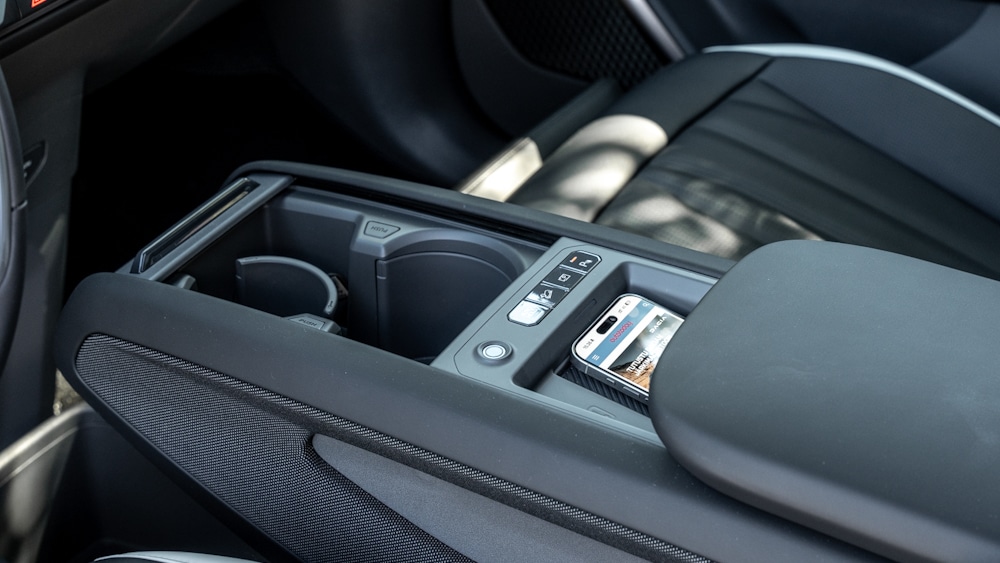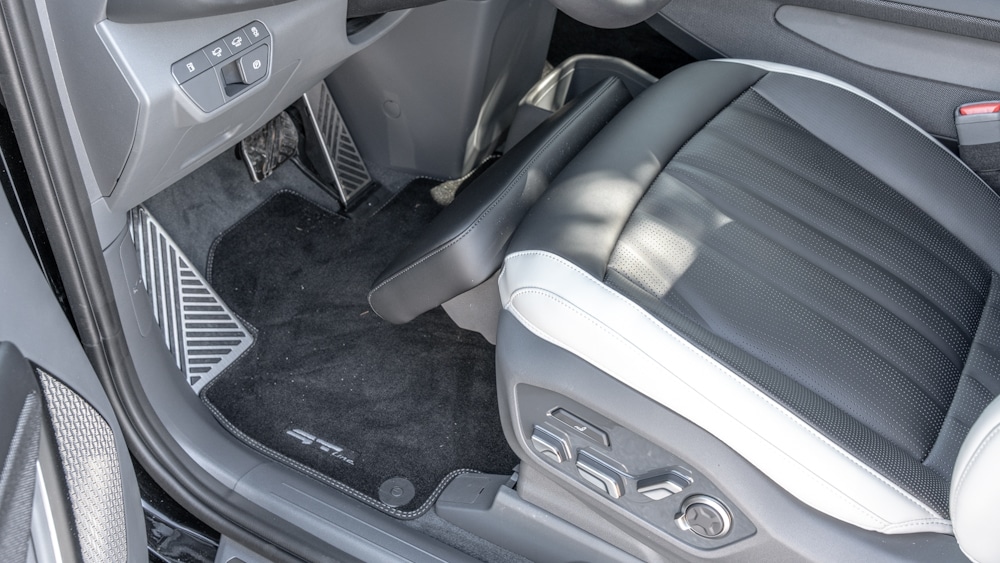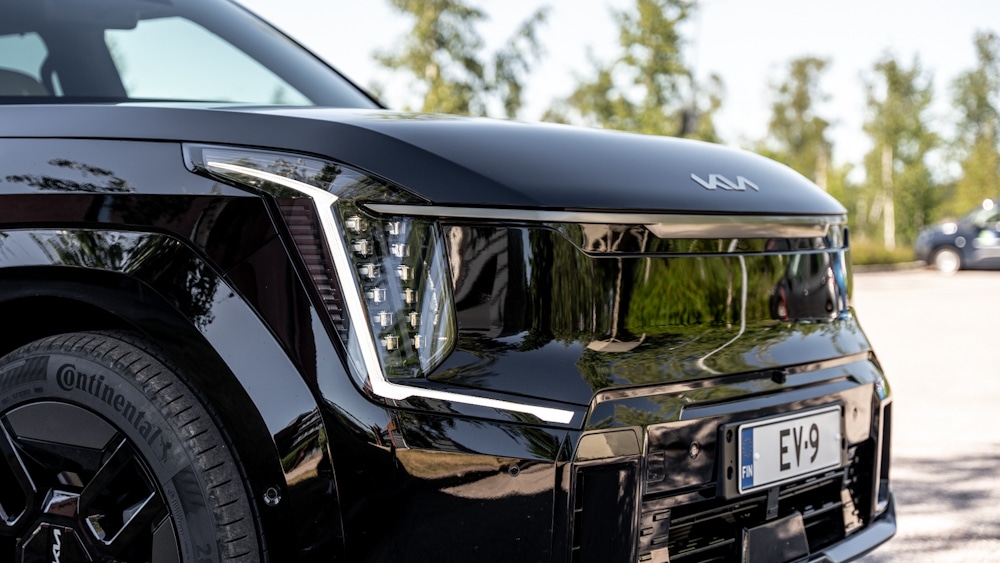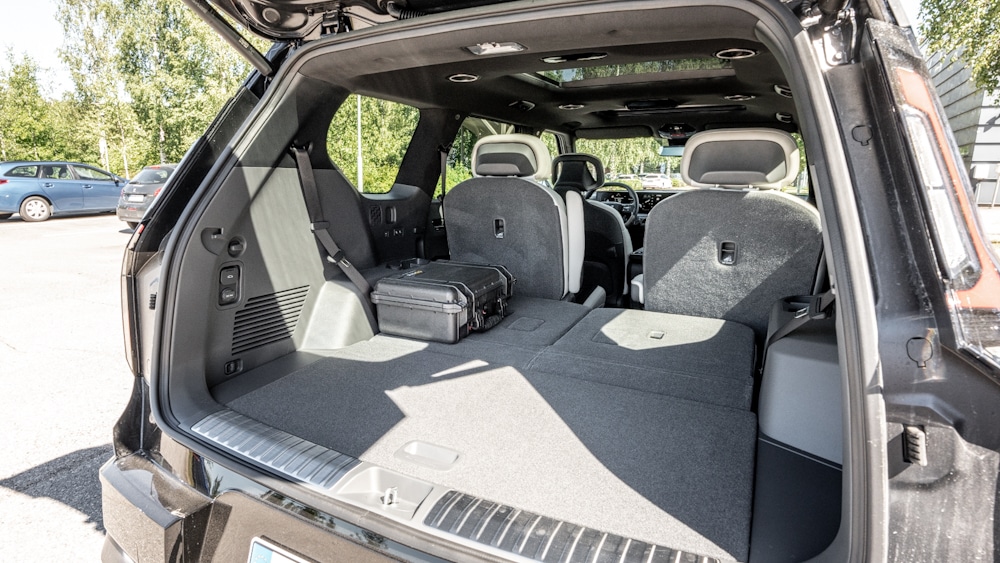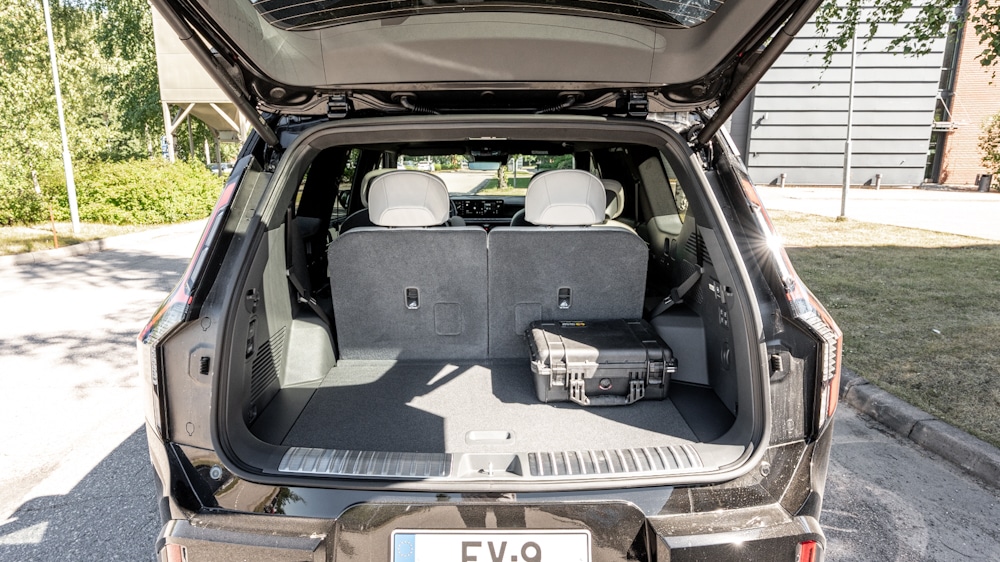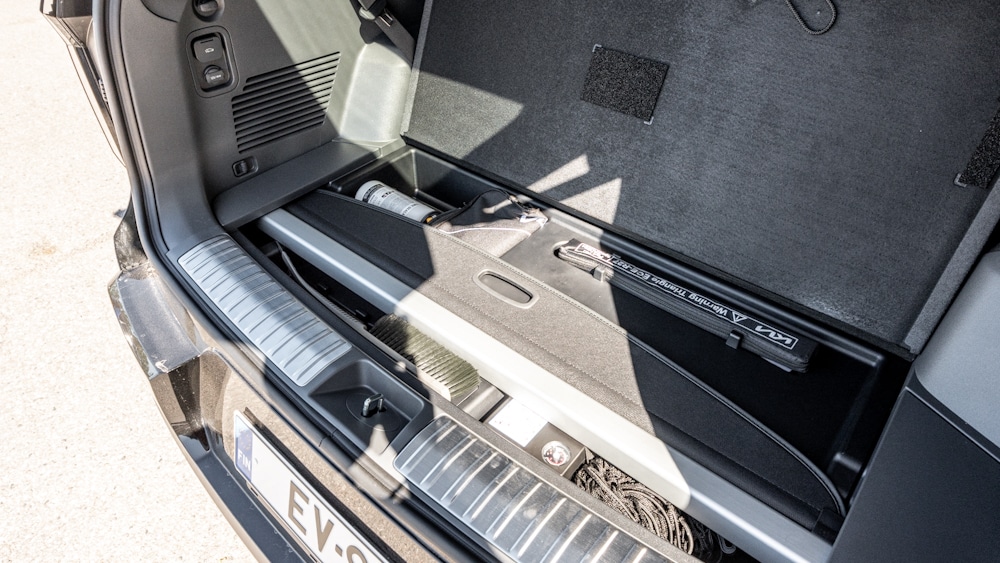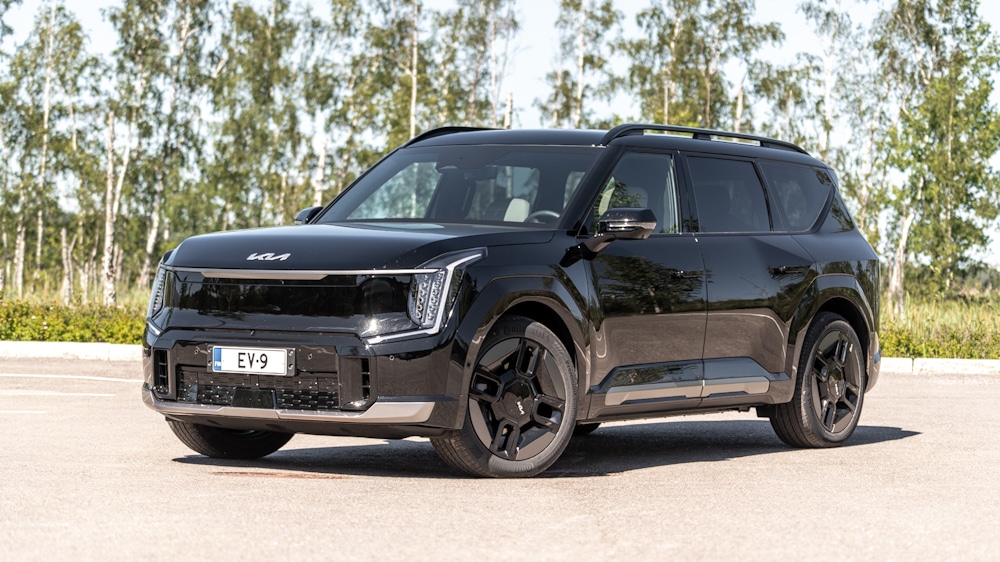The Kia EV9 is the first of its kind and a car without a big brother. Several tens of centimetres shorter than the Kia EV6, the cars share the same E-GMP chassis. The EV6 was in many respects an excellent car, but with the EV9 the manufacturer has literally gone for a bigger number.
If there was some initial wonderment at the EV6’s looks, the EV9 doesn’t bow down to its rivals any more with its bold personal appearance. It’s hard to compare the boldly personal exterior design with rival models sold in Europe, which are virtually absent – the EV9’s looks are more reminiscent of the car market beyond the border. Given the seven-seat version and the all-electric powertrain, the alternatives are eliminated by these criteria.

There have been hints in recent years of Kia’s design direction towards more angular and straightforward models, mainly in terms of lights, details and the new Kia logo. The EV9 is clearly more angular than the brand’s previous models and is likely to set the tone for future Kia innovations. The new EV3 at least seems to continue in this wake of angularity pointed out by the EV9.
The true size of the EV9 was only really felt when standing next to the car and climbing inside. The car is over five metres long and has a wheelbase of no less than 3.1 metres. In the cabin, the pair of eyes look out from so high up that at traffic lights you don’t have to stare at all the lower occupants. Inside, there’s plenty of room to breathe.

The test car was a six-seater Relax model with three rows of seats, two in each row. In the Relax model, seating comfort in the first two rows is tuned to the max. The leather-upholstered comfort seats embrace the passenger with their generous adjustments, good design and heating and cooling functions.
There are power-adjustable supports for the bottoms, just like in the business class of an aircraft. In addition to all the above, the driver can enjoy a seat massage function that makes the journey even more illegally comfortable.
In addition to the six-seater version, there is also a 7-seater model with three seats in the second row instead of two.
The third row of seats is not just for sight and for the smallest in the family. Two adults can travel a little longer on the rearmost seats in reasonable comfort, even if the second row of seats is not as comfortable. The third row of seats folds fully horizontally with electric power, giving a generous 828 litres of luggage space. With all three rows of seats upright, boot space shrinks to 333 litres.

The soundproofing of the cabin also seems to have worked, as tyre noise remains low even at higher speeds. In the GT-Line equipped model tested, the rim size at the front and rear was as much as 21 inches and the tyre size 285/45. The car’s large external dimensions are also reflected in the fact that the tyres do not look in any way too big for the EV9 when viewed from the side.
The EV9’s option list is short, as almost all the equipment comes as standard. A large glass roof with sunroof adds space and brightness to the cabin, and is available as an option, raising the car’s competitive starting price by a crisp €3,300.
Off the pine cones
In the driver’s seat, comfort is not just about low noise levels and good seats. The EV9 also proves to be a pleasure to drive on a variety of roads. The car’s mass and large tyres make for an effortless ride even on the roughest roads. The EV9 literally swallows the bumps of less well-maintained dirt roads, and the driver is surprised time and again how even this bump didn’t feel the way he expected it to on the backside.
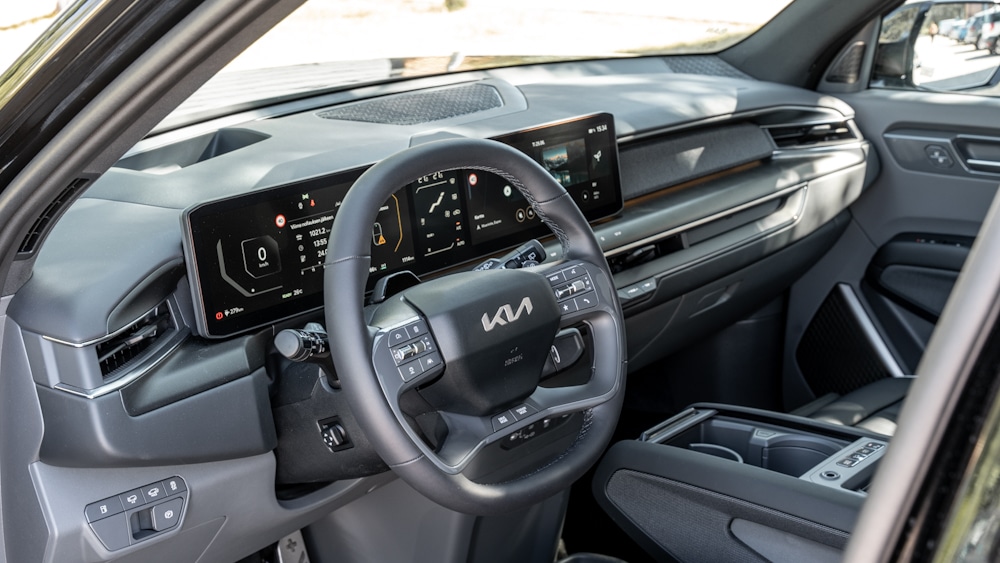
On closer inspection of the chassis, some surface roughness can be felt on a flat road and with a light load. However, it’s worth remembering that at its best there could be up to seven people and their luggage on board, so the chassis still needs to be characterful to maintain ride quality. Air suspension would be the icing on the cake, but unfortunately it is not available as an option.
The suspension does its job nicely and the same can be said for the powertrain. The four-wheel-drive model tested offers a combined 283 kilowatts of power from the two engines and 600 or 700 Newton metres of torque, depending on the four-wheel-drive model. There is no shortage of power and acceleration on Finnish roads. The EV9 is also available as a rear-wheel-drive version with 150 kW, whereby the starting price drops by an impressive EUR 7,000 and the electric range increases from 512 to 563 kilometres.
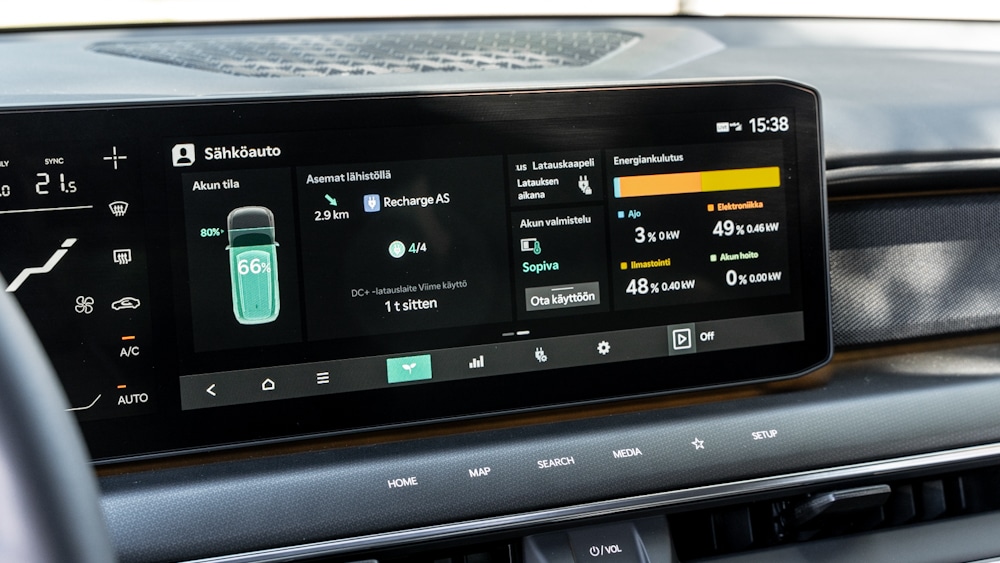
If you opt for the rear-wheel drive model, the maximum weight of the trailer is only 450 kilos with no brakes and 900 kilos with brakes. The corresponding figures for the four-wheel-drive model are 750 and 2500 kilos. The low towing weights of the rear-wheel-drive model should be carefully considered before ordering.
The large exterior dimensions and angular shape take time to become familiar with parking and handling in tight spaces. To make it easier to manoeuvre in tight spaces, there are several cameras around the car with their versatile angles of view. the 360 bird’s-eye view is familiar to many and can also be found on the EV9, but a camera at the bottom of the mirrors, for example, looking into the front wheels, makes it much easier to watch out for canter blinds. The EV9 has a very small turning radius of just over six metres.
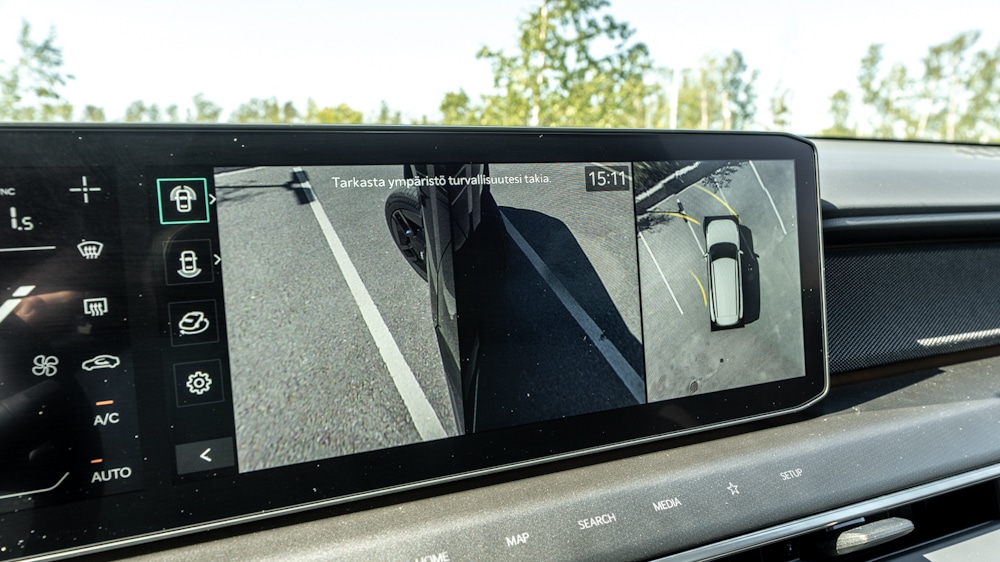
In addition to the traditional mirror, the EV9 has a camera mounted at the top of the tailgate as a rear-view mirror. The view from the camera is not as bright and clear as from a conventional mirror. With a normal mirror, the seats and headrests are in the way. The camera view is clearly different from a normal mirror view, but like the graphics, you quickly get used to the angle of view of a digital mirror.
The excellent driving and handling experience of the EV9 was undermined by a few things. The lane-keeping assist that comes as standard on all EV9 models moved easily from lane to lane, regardless of visibility or lane markings.
The automatic driving system was also repeatedly found to be weak in detecting the car in front when driving with adaptive cruise control. It is as if the car suddenly realises, usually a little too late, that there is a clearly slower car ahead and that it should start slowing down. Automatic lane-changing, on the other hand, is handled smoothly by the automatic system with just a blink of an indicator.
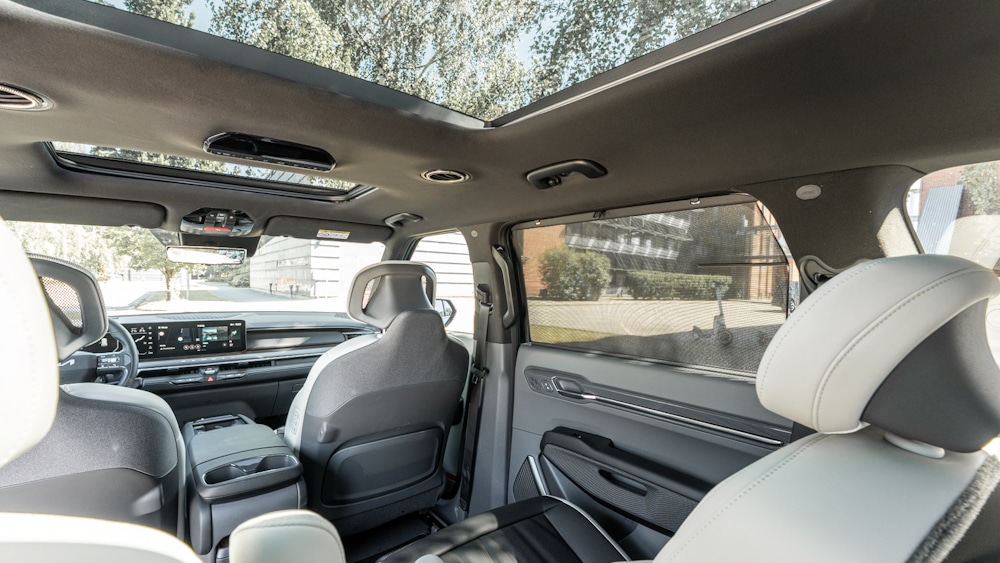
Another obvious area for improvement is the touchscreen displays on the car’s dashboard in terms of visual appearance and, in particular, usability. There is a lot of information and useful functions on the screens, but somehow the Korean presentation and user experience is not convincing. The air conditioning display always remains a separate display between the instrument panel and the instrument cluster.
No time for the cup to cool down during the charging break
Queuing for fast chargers and driving to Lapland in electric cars still seems to be a popular topic of conversation among electric car-shy motorists. As the popularity of electric cars grows, charging station providers are also appearing on major roads, one after the other, while old charging stations are being expanded.

The EV9’s maximum fast-charging power on paper (210 kW.) does not sound like a lot, and at the same time one can doubt the manufacturer’s optimistic 24-minute fast-charging time for a battery charge interval of 10-80%. The car’s architecture is 800-volt technology, so when heading for the charger, it’s a good idea to check the charger’s characteristics beforehand, so as not to be surprised, as I am, by the maximum charging power of just under 100 kW on a 400-volt charger.
Currently, a large number of chargers, especially the newer end units, support 800 volt technology, but there are also many 400 volt only chargers. With an 800 volt charger, the EV9 has an excellent charging curve. In the charge test, the charger was reached with a 10% reserve and the charging power immediately shot up to near maximum. Charging power of at least 200 kilowatts was maintained up to about 60 percent.

In the test, a charge of 10-80% was achieved in 26 minutes of charging. This was only 2 minutes shy of the time stated by the manufacturer. In terms of distance travelled, the amount of charging means around 250-350 extra kilometres in summer weather, depending on speed.

Electricity consumption during the test drive varied between 19-21 kWh/100km for urban driving and 26-27 kWh/100km for motorway driving. In urban and suburban driving, one battery can cover up to 400-500 km and on the motorway 350-400 km depending on speed in summer weather.

To achieve maximum fast-charging performance, battery pre-heating has been made easy. The centre display provides a direct button for battery preparation. The car signals when the battery is at the right temperature for fast charging. You can also prepare the battery by navigating directly to the quick charger, so the car will automatically prepare the battery.
The Kia EV9 is currently a car without worse competitors, given its features and very comprehensive standard equipment, as well as its competitive price. Among the seven-seat all-electric challengers, the closest are Peugeot’s 5008, Tesla’s Model X and Mercedes’ EQB and EQS SUVs.
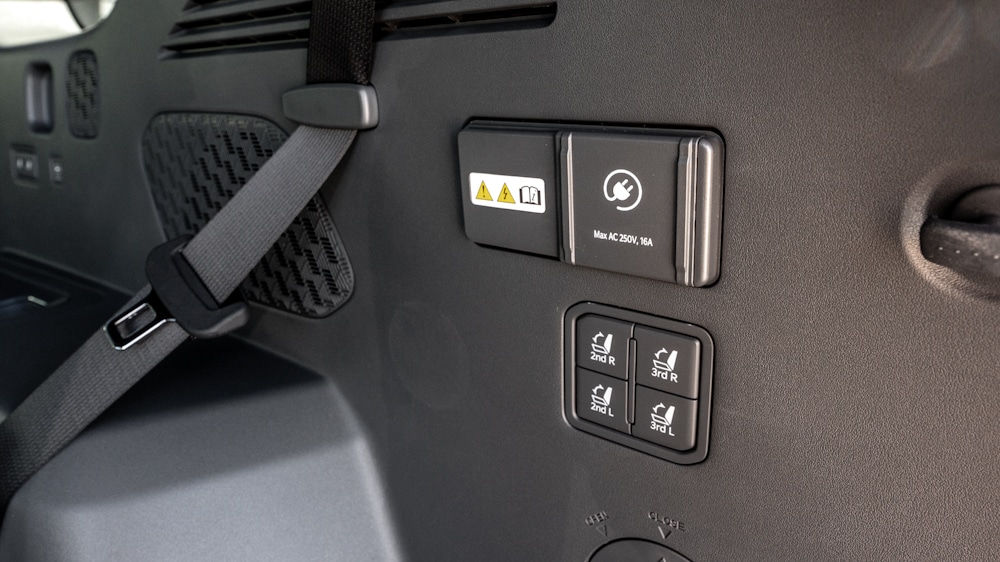
Volvo’s upcoming EX90 will grab its share of the EV9’s demand, but the price with similar equipment will also rise significantly higher – starting from the prices of the Kia EV9 model, which offers a practically complete, versatile and personal package for even the most demanding tastes.
KIA EV9 1st Edition GT-Line AWD 6P Relax
- Electric motor power: 282.6 kW (384 hp)
- Electric motor torque: 600 Nm. (EV9) / 700 Nm. (GT-Line)
- Acceleration: 6.0 (EV9) – 5.3 (GT-Line) sec (0-100 km/h)
- Drive battery capacity: 99.8 kWh.
- Manufacturer’s stated combined fuel consumption: 22.3-22.8 kWh/100km.
- Manufacturer’s declared range (combined): 512-505 km (WLTP)
- Electricity consumption during test drive: 19-27.5 kWh/100km.
- Test-driven range on a single charge: 505-349 km.
- Maximum charging power (DC): 210 kW.
- Maximum charging power (AC): 10.5 kW.
- Deadweight: 2550-2674 kg.
- Cargo space: 828 l. (4P-5P) – 333 l. (6P-7P)
- Drive mode: four-wheel drive
- Towing capacity (with/without brakes): 750 / 2500 kg.
- Starting price: €75,634 (EV9 RWD 7-seater)
- Starting price: €88 463
- Warranty: 7 years / 150 000 km. (first 3 years without km. limit)

